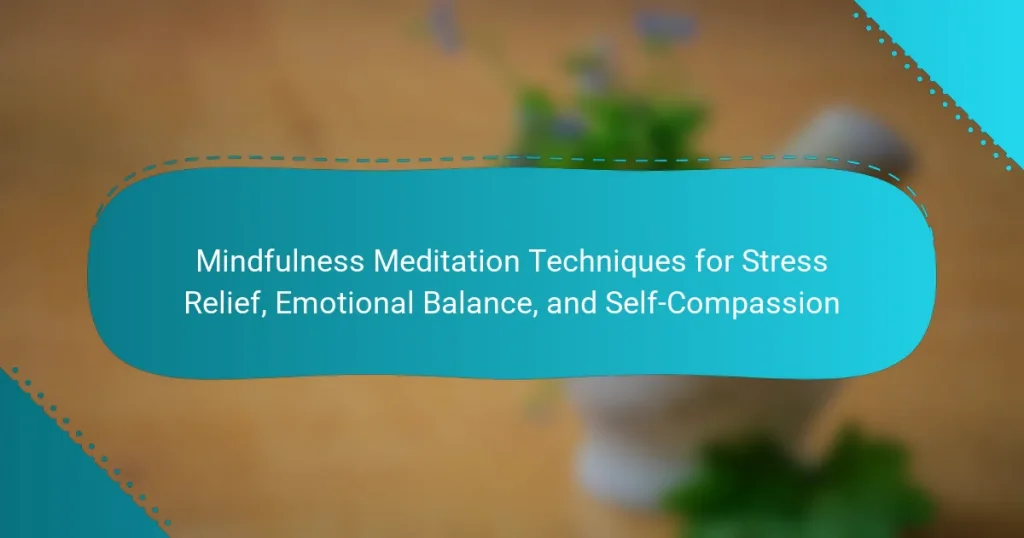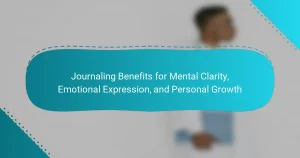Mindfulness meditation techniques effectively reduce stress, enhance emotional balance, and cultivate self-compassion. Focused breathing anchors thoughts and alleviates anxiety. Body scan increases awareness of physical sensations, promoting tension release. Loving-kindness meditation fosters empathy and emotional resilience, leading to improved well-being. Regular practice of these techniques can significantly enhance overall emotional health.
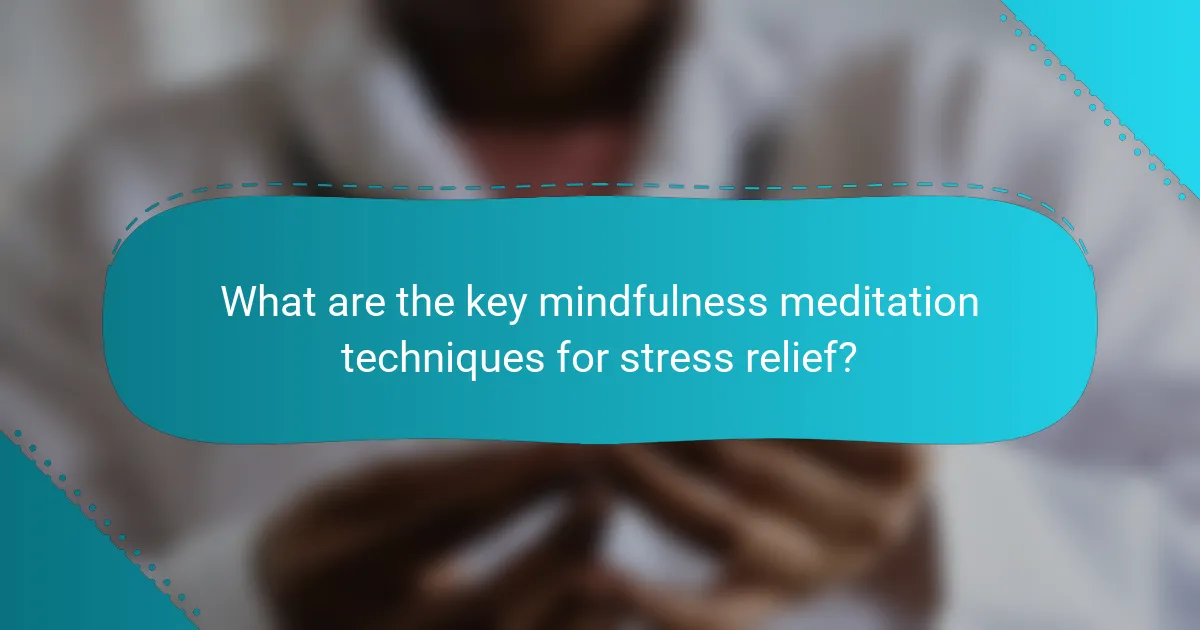
What are the key mindfulness meditation techniques for stress relief?
Mindfulness meditation techniques for stress relief include focused breathing, body scan, and loving-kindness meditation. These practices enhance emotional balance and cultivate self-compassion.
Focused breathing involves concentrating on your breath to anchor your thoughts, reducing anxiety effectively. Body scan promotes awareness of physical sensations, helping release tension. Loving-kindness meditation fosters empathy and compassion, improving emotional resilience.
Regular practice of these techniques can lead to a significant reduction in stress levels, enhancing overall well-being.
How does mindfulness meditation impact stress levels?
Mindfulness meditation significantly reduces stress levels by promoting relaxation and emotional regulation. Studies show that consistent practice leads to lower cortisol levels, enhancing overall well-being. Additionally, mindfulness techniques foster self-compassion, which further mitigates stress responses. Engaging in mindfulness practices can create a lasting impact on emotional balance, providing tools to cope with daily stressors effectively.
What are the most effective techniques for beginners?
Mindfulness meditation techniques for beginners include focused breathing, body scan, and loving-kindness meditation. These methods promote stress relief, emotional balance, and self-compassion.
1. Focused Breathing: Concentrate on your breath to anchor your mind, reducing anxiety and enhancing awareness.
2. Body Scan: Move attention through your body, noticing sensations to foster relaxation and connection.
3. Loving-Kindness Meditation: Cultivate compassion by sending positive thoughts to yourself and others, improving emotional well-being.
These techniques are effective starting points for developing a mindfulness practice.
What is the body scan technique?
The body scan technique is a mindfulness practice that promotes awareness of physical sensations and emotional states. It involves systematically focusing attention on different parts of the body, helping to cultivate self-compassion and emotional balance. This technique can reduce stress and enhance relaxation, making it a valuable tool in mindfulness meditation. Practitioners often find that this method deepens their connection to the present moment, allowing for greater emotional clarity and well-being.
How to practice mindful breathing?
To practice mindful breathing, focus on your breath and maintain awareness of each inhale and exhale. Begin by finding a comfortable position, either sitting or lying down. Close your eyes and take a deep breath in through your nose, filling your lungs completely. As you exhale through your mouth, release any tension. Continue this pattern, allowing your mind to settle on the rhythm of your breath. If your thoughts wander, gently bring your focus back to your breathing. This technique fosters emotional balance and enhances self-compassion. Aim for at least five minutes daily to cultivate mindfulness effectively.
What is loving-kindness meditation?
Loving-kindness meditation is a mindfulness practice focused on cultivating compassion and love towards oneself and others. This technique enhances emotional balance and self-compassion, making it effective for stress relief. Research indicates that regular practice can increase positive emotions and improve overall well-being. It typically involves repeating phrases that express good wishes for oneself and others, fostering a sense of connection and empathy.
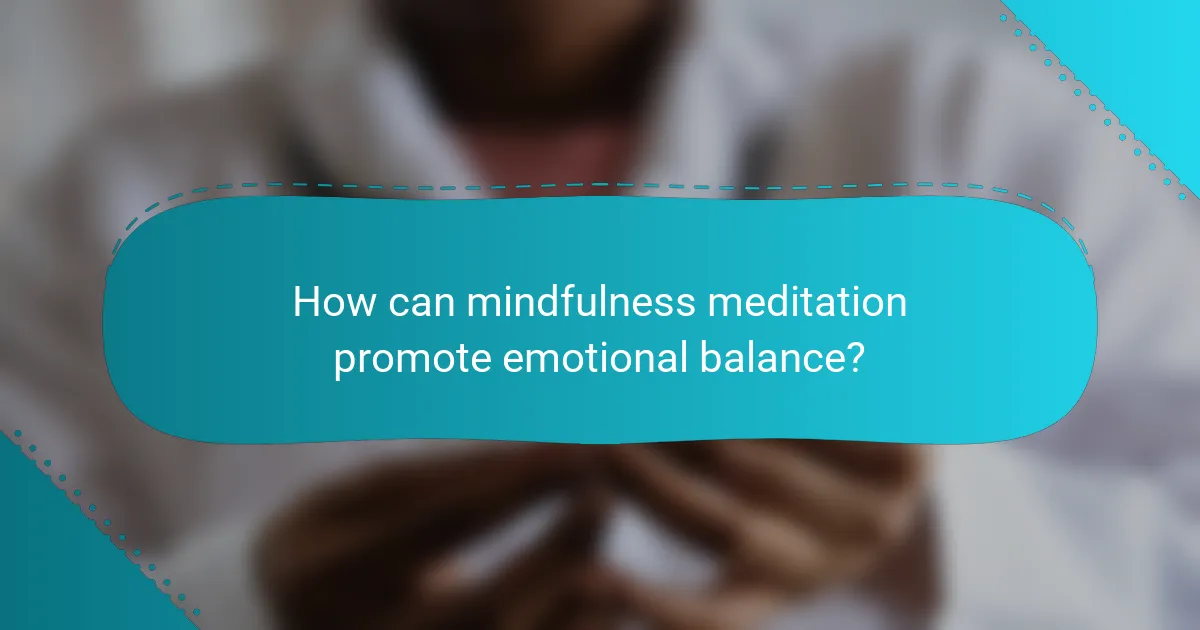
How can mindfulness meditation promote emotional balance?
Mindfulness meditation promotes emotional balance by enhancing self-awareness and reducing stress. Practicing mindfulness helps individuals recognize and manage their emotions more effectively, leading to improved emotional regulation. Research indicates that mindfulness techniques can decrease anxiety and increase feelings of well-being. Regular practice fosters self-compassion, allowing individuals to respond to their emotional states with kindness rather than judgment. These benefits contribute to a more stable emotional state and resilience against stressors.
What role does mindfulness play in emotional regulation?
Mindfulness plays a crucial role in emotional regulation by enhancing awareness and acceptance of emotions. It helps individuals observe their thoughts and feelings without judgment, leading to better emotional balance and reduced stress. Research indicates that regular mindfulness practice can lower anxiety and improve overall emotional well-being. Techniques such as breath awareness and body scanning focus attention, fostering self-compassion and resilience in the face of challenging emotions.
Which techniques enhance emotional awareness?
Mindfulness meditation techniques enhance emotional awareness by promoting present-moment focus and self-reflection. Techniques such as body scan, loving-kindness meditation, and breath awareness cultivate deeper emotional insight. These practices encourage recognizing and accepting emotions without judgment, fostering emotional balance and resilience. Regular practice can lead to increased self-compassion and reduced stress, ultimately improving overall emotional well-being.
How to use journaling alongside meditation?
Journaling enhances mindfulness meditation by deepening self-reflection and emotional awareness. To use journaling alongside meditation, follow these steps:
1. Set a specific time for both practices, ideally after meditation.
2. Begin with a brief meditation session to clear your mind.
3. Write freely about your thoughts, feelings, or insights gained during meditation.
4. Reflect on your entries regularly to track emotional patterns and growth.
This combination fosters emotional balance and self-compassion, reinforcing the benefits of mindfulness meditation.
What is the impact of guided imagery?
Guided imagery significantly enhances mindfulness meditation techniques by fostering stress relief, emotional balance, and self-compassion. This practice utilizes visualization to create mental images that promote relaxation and emotional healing. As a result, individuals often experience reduced anxiety and improved mood. Research indicates that guided imagery can lower cortisol levels, contributing to overall well-being. Additionally, it encourages self-reflection, allowing practitioners to cultivate deeper self-compassion and emotional awareness.
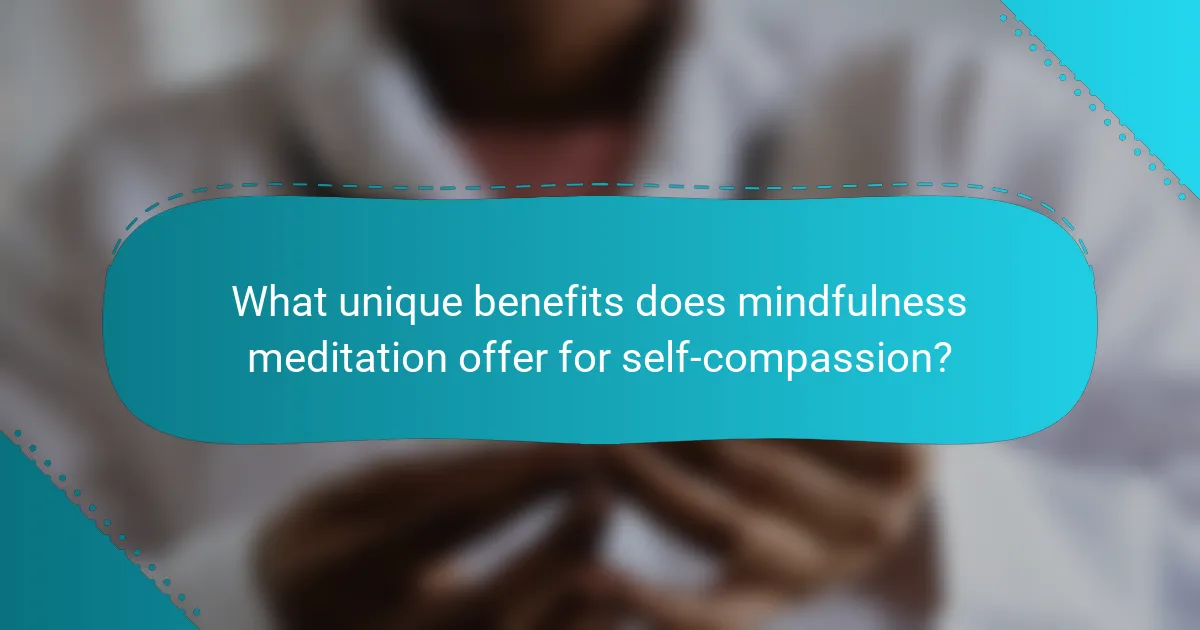
What unique benefits does mindfulness meditation offer for self-compassion?
Mindfulness meditation uniquely enhances self-compassion by fostering a non-judgmental awareness of thoughts and feelings. This practice cultivates emotional resilience, allowing individuals to respond to suffering with kindness rather than criticism. Research indicates that regular mindfulness meditation can significantly reduce self-criticism and increase self-acceptance. By promoting a compassionate inner dialogue, mindfulness meditation creates a supportive mental environment, which is essential for emotional well-being.
How can self-compassion be cultivated through mindfulness?
Self-compassion can be cultivated through mindfulness by practicing awareness and acceptance of one’s thoughts and feelings. Mindfulness meditation techniques encourage individuals to observe their inner experiences without judgment, fostering a compassionate response to personal struggles. This practice helps in recognizing common humanity, reducing feelings of isolation. Techniques like breath awareness and body scans can enhance emotional balance, allowing for a kinder self-dialogue. As a result, individuals develop resilience against stress and improve overall well-being.
What specific techniques enhance self-compassion?
Mindfulness meditation techniques that enhance self-compassion include loving-kindness meditation, body scan meditation, and mindful self-reflection. Loving-kindness meditation fosters positive emotions towards oneself and others. Body scan meditation increases awareness of bodily sensations, promoting acceptance. Mindful self-reflection encourages individuals to observe thoughts without judgment, enhancing emotional balance. These techniques collectively nurture self-compassion and reduce stress.
How does self-compassion meditation differ from other forms?
Self-compassion meditation focuses on nurturing kindness towards oneself, differing from other mindfulness techniques that may emphasize awareness or detachment. This practice cultivates emotional resilience by encouraging self-acceptance, contrasting with traditional mindfulness that often centers on observing thoughts without judgment. Self-compassion meditation uniquely integrates affirmations and loving-kindness, fostering a supportive inner dialogue. As a result, practitioners often experience enhanced emotional balance and reduced stress levels compared to standard mindfulness methods.
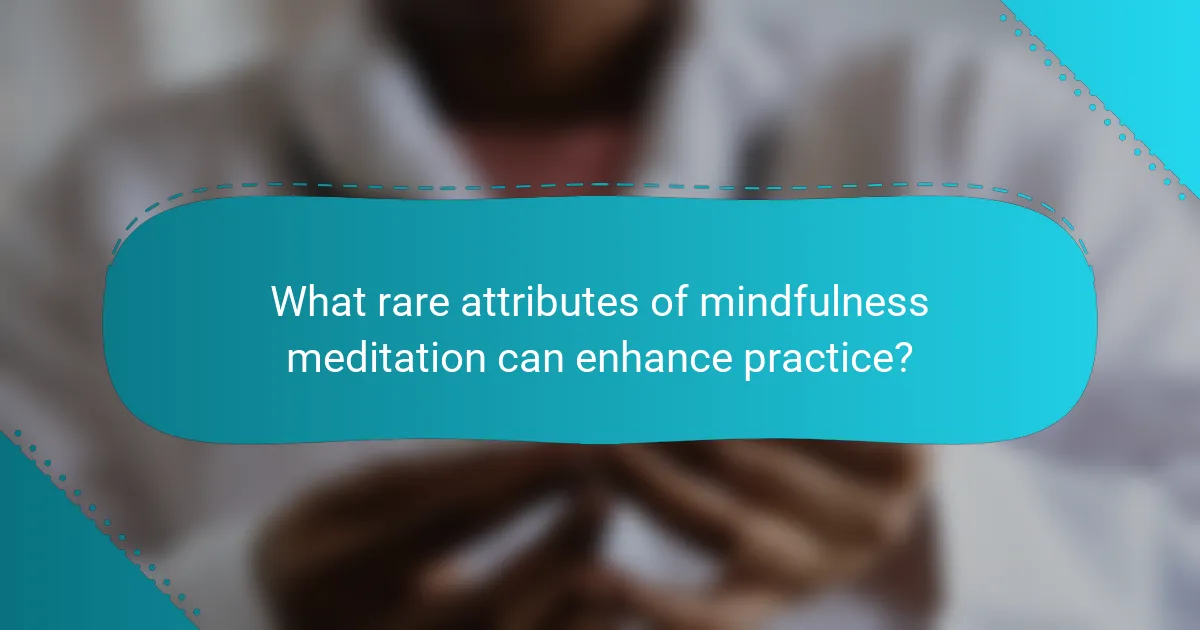
What rare attributes of mindfulness meditation can enhance practice?
Rare attributes of mindfulness meditation that can enhance practice include the ability to induce a flow state, promote neuroplasticity, and foster a unique sense of interconnectedness. These attributes contribute to deeper emotional resilience and enhanced self-awareness. For example, the flow state can lead to heightened focus and creativity, while neuroplasticity supports lasting changes in thought patterns. Interconnectedness fosters compassion and empathy, enriching personal relationships and overall well-being.
How can mindfulness meditation improve interpersonal relationships?
Mindfulness meditation significantly enhances interpersonal relationships by fostering emotional balance and self-compassion. Practicing mindfulness helps individuals become more aware of their thoughts and feelings, leading to better communication and empathy. This awareness allows for healthier responses in challenging situations, reducing stress and conflict. Research indicates that individuals who engage in mindfulness meditation report improved relationship satisfaction and deeper connections with others. By cultivating a non-judgmental attitude, mindfulness promotes understanding and acceptance, essential components in building strong interpersonal bonds.
What are the uncommon practices that deepen meditation experience?
Uncommon practices that deepen meditation experience include integrating sound therapy, utilizing breath patterns, and engaging in mindful movement. Sound therapy, such as using singing bowls, enhances focus and relaxation. Specific breath patterns, like box breathing, promote emotional balance. Mindful movement, through practices like Tai Chi, fosters self-compassion and connection to the body. These techniques add depth to mindfulness meditation, enriching the overall experience.
How to integrate mindful movement into meditation?
Integrating mindful movement into meditation enhances focus and deepens awareness. Start with gentle yoga or tai chi, allowing the body to flow with breath. This combination fosters emotional balance and self-compassion, promoting a holistic approach to mindfulness. As a result, practitioners often experience reduced stress levels and improved mental clarity.
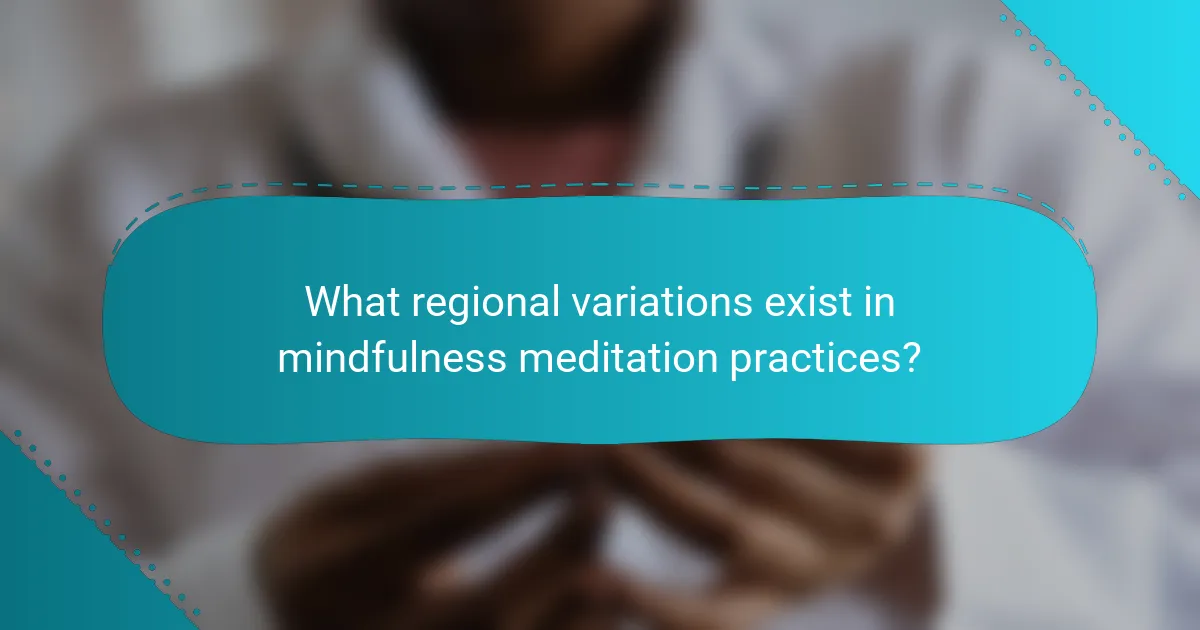
What regional variations exist in mindfulness meditation practices?
Mindfulness meditation practices vary significantly across regions, influenced by cultural beliefs and traditions. In Asia, practices often integrate spiritual elements, focusing on enlightenment and awareness. Conversely, Western adaptations emphasize stress relief and emotional balance, often secularizing techniques for broader accessibility. Unique attributes include the use of specific mantras in Tibetan Buddhism and the incorporation of yoga in Indian practices. Rarely, some regions blend mindfulness with local traditions, creating distinct styles that reflect their cultural heritage.
How do cultural perceptions influence mindfulness techniques?
Cultural perceptions significantly shape mindfulness techniques by influencing practices, beliefs, and applications. Different cultures interpret mindfulness uniquely, affecting its integration into daily life. For instance, Eastern traditions often emphasize collective well-being, while Western approaches may focus on individual benefits. This cultural lens can impact the effectiveness and acceptance of mindfulness techniques across diverse populations. Understanding these variations fosters a more inclusive practice, enhancing emotional balance and self-compassion in a global context.
What mindfulness techniques are popular in different regions?
Mindfulness techniques vary globally, reflecting cultural influences and practices. Common techniques include:
1. **Zen Meditation (Zazen)** – Originating from Japan, focuses on breath awareness and posture.
2. **Vipassana** – An ancient practice from India emphasizing insight through observation of thoughts and sensations.
3. **Loving-Kindness Meditation (Metta)** – Popular in Thailand, cultivates compassion and goodwill towards oneself and others.
4. **Mindful Walking** – Practiced in various cultures, integrates movement with awareness of the environment.
5. **Body Scan** – Common in Western practices, involves mentally scanning the body for tension and relaxation.
6. **Guided Imagery** – Often used in therapeutic settings, utilizes visualization to promote relaxation and emotional balance.
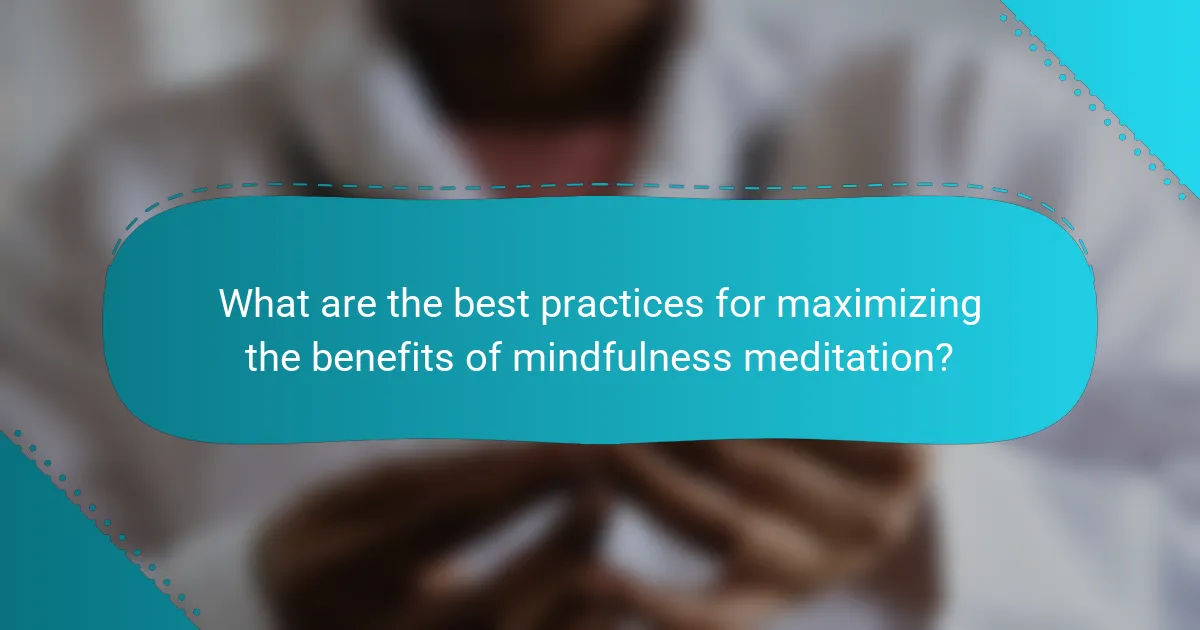
What are the best practices for maximizing the benefits of mindfulness meditation?
To maximize the benefits of mindfulness meditation, practice consistently, focus on your breath, and cultivate self-compassion. Start with short sessions, gradually increasing duration as comfort grows. Use guided meditations to enhance focus and explore different techniques. Create a dedicated space free from distractions to deepen your practice. Journaling after sessions can help process emotions and reinforce insights gained.
What common mistakes should be avoided in mindfulness meditation?
To enhance mindfulness meditation, avoid common mistakes such as rushing the practice, forcing thoughts away, and expecting immediate results. These errors can hinder stress relief, emotional balance, and self-compassion. Focus on being present and gentle with yourself during the process.
How can one create a sustainable meditation practice?
To create a sustainable meditation practice, establish a consistent schedule, start with short sessions, and gradually increase duration. Incorporate mindfulness meditation techniques that focus on stress relief, emotional balance, and self-compassion.
Begin by setting aside a specific time each day, even if it’s just five minutes. Use guided meditations or apps to support your practice. As you become more comfortable, extend your sessions and explore different techniques, such as loving-kindness meditation or body scans, to enhance emotional awareness and self-compassion.
Track your progress to stay motivated and adjust your practice as needed. Engaging in a community or finding a meditation partner can also provide support and accountability.
What expert tips can enhance mindfulness meditation effectiveness?
To enhance mindfulness meditation effectiveness, focus on consistency, environment, and technique. Establish a daily routine to cultivate habit. Create a calm space free from distractions to promote relaxation. Experiment with techniques like breath awareness, body scans, or loving-kindness practices to find what resonates.
